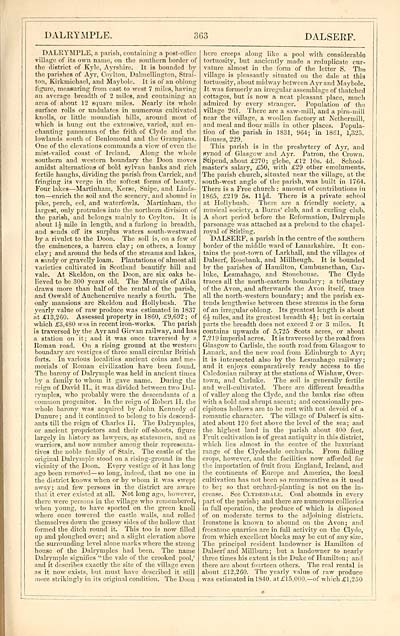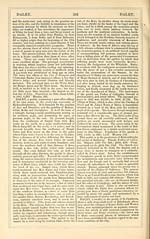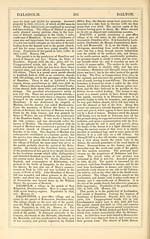Download files
Complete book:
Individual page:
Thumbnail gallery: Grid view | List view

DALRYMPLE.
3G3
DALSERF.
DALRYMPLE, a parish, containing a poBt-olb'ee
villager of its own name, on the southern border of
the district of Kyle, Ayrshire. It is bounded by
the parishes of Ayr, Coylton, Dalmellington, Strai-
ten, Kh'kmiehacl, and Maybole. It is of an oblong
figure, measuring from east to west 7 miles, having
an average breadth of 2 miles, and containing an
area of about 12 square miles. Nearly its whole
surface rolls or undulates in numerous cultivated
knolls, or little moundish bills, around most of
which is bung out the extensive, varied, and en-
chanting panorama of the frith of Clyde and the
lowlands south of Benlomond and the Grampians.
One of the elevations commands a view of even the
mist-vailed coast of Ireland. Along the whole
southern and western boundary the Doon moves
amidst alternations of bold sylvan banks and rich
fertile haughs, dividing the parish from Carrick, and
fringing its verge in the softest forms of beauty.
Four lakes — Martinham, ICerse, Snipe, and Linds-
ton — enrich the soil and the scenery, and abound i n
pike, perch, eel, and waterfowls. Martinham, the
largest, only protrudes into the northern division of
the parish, and belongs mainly to Coylton. It is
about 1J mile in length, and a furlong in breadth,
and sends off its surplus waters south-westward
by a rivulet to the Doon. The soil is, on a few of
the eminences, a barren clay ; on others, a loamy
clay ; and around the beds of the streams and lakes,
a sandy or gravelly loam. Plantations of almost all
varieties cultivated in Scotland beautify hill and
vale. At Skeldon, on the Doon, are six oaks be-
lieved to be 300 years old. The Marquis of Ailsa
draws more than half of the rental of the parish,
and Oswald of Auchencruive nearly a fourth. The
only mansions are Skeldon and Hollybush. The
yearly value of raw produce was estimated in 1837
at £13,260. Assessed property in I860, £9,692 ; of
which £3,480 was in recent iron-works. The parish
is traversed by the Ayr and Girvan railway, and has
a station on it; and it was once traversed by a
Roman road. On a rising ground at the western
boundary are vestiges of three small circular British
forts. In various localities ancient coins and me-
morials of Roman civilization have been found.
The barony of Dahymple was held in ancient times
by a family to whom it gave name. During the
reign of David II., it was divided between two Dal-
rymples, who probably were the descendants of a
common progenitor. In the reign of Eobert II. the
whole barony was acquired by John Kennedy of
Dunure ; and it continued to belong to his descend-
ants till the reign of Charles II. The Dalrymples,
or ancient proprietors and their off-shoots, figure
largely in history as lawyers, as statesmen, and as
warriors, and now number among their representa-
tives the noble family of Stair. The castle of the
original Dalrymple stood on a rising-ground in the
vicinity of the Doon. Every vestige of it has long
ago been removed — so long, indeed, that no one in
the district knows when or by whom it was swept
away; and few persons in the district are aware
that it ever existed at all. Not long ago, however,
there were persons in the village who remembered,
when young, to have sported ''on the green knoll
where once towered the castle walls, and rolled
themselves down the grassy sides of the hollow that
formed the ditch round it. This too is now filled
up and ploughed over; and a slight elevation above
the surrounding level alone marks where the strong
house of the Dalrymples bad been. The name
Dalrymple signifies "the vale of the crooked pool,'
and it describes exactly the site of the village even
as it now exists, but must have described it still
more strikingly in its original condition. The Doon
here creeps along like a pool with considerable
tortuosity, but anciently made a reduplicate cur-
vature almost in the form of the letter S. The
village is pleasantly situated on the dale at this
tortuosity, about midway between Ayr and Maybole.
It was formerly an irregular assemblage of thatched
cottages, but is now a neat pleasant place, much
admired by every stranger. Population of tho
village 261. There are a saw-mill, and a pim-mill
near the village, a woollen factory at Nethermill,
and meal and Hour mills in other places. Popula-
tion of the parish in 1831, 964; in 1861, 1,325.
Houses, 229.
This parish is in the presbytery of Ayr, and
synod of Glasgow and Ayr. Patron, the Crown.
Stipend, about £270; glebe, £12 10s. 4d. School-
master's salary, £50, with £29 other emoluments.
The parish church, situated near the village, at the
south-west angle of the parish, was built in 1764.
There is a Free church : amount of contributions in
1865, £219 5s. 1 1 id. There is a private school
at Hollybush. There are a friendly society, a
musical society, a Burns' club, and a curling club.
A short period before the Reformation, Dalrymple
parsonage was attached as a prebend to the chapel-
royal of Stirling.
DALSERF, a parish in the centre of the southern
border of the middle ward of Lanarkshire. It con-
tains the post-town of Larkhall, and the villages of
Dalserf, Rosebank, and Millheugh. It is bounded
by the parishes of Hamilton, Cambusnethan, Car-
luke, Lesmahago, and Stonehouse. The Clyde
traces all the north-eastern boundary; a tributary
of the Avon, and afterwards the Avon itself, trace
all the north-western boundary; and the parish ex-
tends lengthwise between these streams in the form
of an irregular oblong. Its greatest length is about
6 § miles, and its greatest breadth 4J; but in certain
parts the breadth does not exceed 2 or 3 miles. It
contains upwards of 5,725 Scots acres, or about
7,2 1 9 imperial acres. It is traversed by the road from
Glasgow to Carlisle, the south road from Glasgow to
Lanark, and the new road from Edinburgh to Ayr;
it is intersected also by the Lesmahago railway;
and it enjoys comparatively ready access to the
Caledonian railway at the stations of Wishaw, Over-
town, and Carluke. The soil is generally fertile
and well-cultivated. There are different breadths
of valley along the Clyde, and the banks rise often
with a bold and abrupt ascent; and occasionally pre-
cipitous hollows are to be met with not devoid of a
romantic character. The village of Dalserf is situ-
ated about 120 feet above the level of the sea; and
the highest land in the parish about 400 feet.
Fruit cultivation is of great antiquity in this district,
which lies almost in the centre of the luxuriant
range of the Clydesdale orchards. From failing
crops, however, and the facilities now afforded for
the importation of fruit from England, Ireland, and
the continents of Europe and America, the local
cultivation has not been so remunerative as it used
to be ; so that orchard -planting is not on the in-
crease. See Clydesdale. Coal abounds in every
part of the parish ; and there are numerous collieries
in full operation, the produce of which is disposed
of on moderate terms to the adjoining districts.
Ironstone is known to abound on the Avon; and
freestone quarries are in full activity on the Clyde,
from which excellent blocks may be cut of any size.
The principal resident landowner is Hamilton oi
Dalserf and Millburn; but a landowner to nearly
three times his extent is the Duke of Hamilton ; and
there are about fourteen others. The real rental is
about £12,260. The yearly value of raw produce
was estimated in 1840. at £15,000, —of which £1,250
3G3
DALSERF.
DALRYMPLE, a parish, containing a poBt-olb'ee
villager of its own name, on the southern border of
the district of Kyle, Ayrshire. It is bounded by
the parishes of Ayr, Coylton, Dalmellington, Strai-
ten, Kh'kmiehacl, and Maybole. It is of an oblong
figure, measuring from east to west 7 miles, having
an average breadth of 2 miles, and containing an
area of about 12 square miles. Nearly its whole
surface rolls or undulates in numerous cultivated
knolls, or little moundish bills, around most of
which is bung out the extensive, varied, and en-
chanting panorama of the frith of Clyde and the
lowlands south of Benlomond and the Grampians.
One of the elevations commands a view of even the
mist-vailed coast of Ireland. Along the whole
southern and western boundary the Doon moves
amidst alternations of bold sylvan banks and rich
fertile haughs, dividing the parish from Carrick, and
fringing its verge in the softest forms of beauty.
Four lakes — Martinham, ICerse, Snipe, and Linds-
ton — enrich the soil and the scenery, and abound i n
pike, perch, eel, and waterfowls. Martinham, the
largest, only protrudes into the northern division of
the parish, and belongs mainly to Coylton. It is
about 1J mile in length, and a furlong in breadth,
and sends off its surplus waters south-westward
by a rivulet to the Doon. The soil is, on a few of
the eminences, a barren clay ; on others, a loamy
clay ; and around the beds of the streams and lakes,
a sandy or gravelly loam. Plantations of almost all
varieties cultivated in Scotland beautify hill and
vale. At Skeldon, on the Doon, are six oaks be-
lieved to be 300 years old. The Marquis of Ailsa
draws more than half of the rental of the parish,
and Oswald of Auchencruive nearly a fourth. The
only mansions are Skeldon and Hollybush. The
yearly value of raw produce was estimated in 1837
at £13,260. Assessed property in I860, £9,692 ; of
which £3,480 was in recent iron-works. The parish
is traversed by the Ayr and Girvan railway, and has
a station on it; and it was once traversed by a
Roman road. On a rising ground at the western
boundary are vestiges of three small circular British
forts. In various localities ancient coins and me-
morials of Roman civilization have been found.
The barony of Dahymple was held in ancient times
by a family to whom it gave name. During the
reign of David II., it was divided between two Dal-
rymples, who probably were the descendants of a
common progenitor. In the reign of Eobert II. the
whole barony was acquired by John Kennedy of
Dunure ; and it continued to belong to his descend-
ants till the reign of Charles II. The Dalrymples,
or ancient proprietors and their off-shoots, figure
largely in history as lawyers, as statesmen, and as
warriors, and now number among their representa-
tives the noble family of Stair. The castle of the
original Dalrymple stood on a rising-ground in the
vicinity of the Doon. Every vestige of it has long
ago been removed — so long, indeed, that no one in
the district knows when or by whom it was swept
away; and few persons in the district are aware
that it ever existed at all. Not long ago, however,
there were persons in the village who remembered,
when young, to have sported ''on the green knoll
where once towered the castle walls, and rolled
themselves down the grassy sides of the hollow that
formed the ditch round it. This too is now filled
up and ploughed over; and a slight elevation above
the surrounding level alone marks where the strong
house of the Dalrymples bad been. The name
Dalrymple signifies "the vale of the crooked pool,'
and it describes exactly the site of the village even
as it now exists, but must have described it still
more strikingly in its original condition. The Doon
here creeps along like a pool with considerable
tortuosity, but anciently made a reduplicate cur-
vature almost in the form of the letter S. The
village is pleasantly situated on the dale at this
tortuosity, about midway between Ayr and Maybole.
It was formerly an irregular assemblage of thatched
cottages, but is now a neat pleasant place, much
admired by every stranger. Population of tho
village 261. There are a saw-mill, and a pim-mill
near the village, a woollen factory at Nethermill,
and meal and Hour mills in other places. Popula-
tion of the parish in 1831, 964; in 1861, 1,325.
Houses, 229.
This parish is in the presbytery of Ayr, and
synod of Glasgow and Ayr. Patron, the Crown.
Stipend, about £270; glebe, £12 10s. 4d. School-
master's salary, £50, with £29 other emoluments.
The parish church, situated near the village, at the
south-west angle of the parish, was built in 1764.
There is a Free church : amount of contributions in
1865, £219 5s. 1 1 id. There is a private school
at Hollybush. There are a friendly society, a
musical society, a Burns' club, and a curling club.
A short period before the Reformation, Dalrymple
parsonage was attached as a prebend to the chapel-
royal of Stirling.
DALSERF, a parish in the centre of the southern
border of the middle ward of Lanarkshire. It con-
tains the post-town of Larkhall, and the villages of
Dalserf, Rosebank, and Millheugh. It is bounded
by the parishes of Hamilton, Cambusnethan, Car-
luke, Lesmahago, and Stonehouse. The Clyde
traces all the north-eastern boundary; a tributary
of the Avon, and afterwards the Avon itself, trace
all the north-western boundary; and the parish ex-
tends lengthwise between these streams in the form
of an irregular oblong. Its greatest length is about
6 § miles, and its greatest breadth 4J; but in certain
parts the breadth does not exceed 2 or 3 miles. It
contains upwards of 5,725 Scots acres, or about
7,2 1 9 imperial acres. It is traversed by the road from
Glasgow to Carlisle, the south road from Glasgow to
Lanark, and the new road from Edinburgh to Ayr;
it is intersected also by the Lesmahago railway;
and it enjoys comparatively ready access to the
Caledonian railway at the stations of Wishaw, Over-
town, and Carluke. The soil is generally fertile
and well-cultivated. There are different breadths
of valley along the Clyde, and the banks rise often
with a bold and abrupt ascent; and occasionally pre-
cipitous hollows are to be met with not devoid of a
romantic character. The village of Dalserf is situ-
ated about 120 feet above the level of the sea; and
the highest land in the parish about 400 feet.
Fruit cultivation is of great antiquity in this district,
which lies almost in the centre of the luxuriant
range of the Clydesdale orchards. From failing
crops, however, and the facilities now afforded for
the importation of fruit from England, Ireland, and
the continents of Europe and America, the local
cultivation has not been so remunerative as it used
to be ; so that orchard -planting is not on the in-
crease. See Clydesdale. Coal abounds in every
part of the parish ; and there are numerous collieries
in full operation, the produce of which is disposed
of on moderate terms to the adjoining districts.
Ironstone is known to abound on the Avon; and
freestone quarries are in full activity on the Clyde,
from which excellent blocks may be cut of any size.
The principal resident landowner is Hamilton oi
Dalserf and Millburn; but a landowner to nearly
three times his extent is the Duke of Hamilton ; and
there are about fourteen others. The real rental is
about £12,260. The yearly value of raw produce
was estimated in 1840. at £15,000, —of which £1,250
Set display mode to: Large image | Transcription
Images and transcriptions on this page, including medium image downloads, may be used under the Creative Commons Attribution 4.0 International Licence unless otherwise stated. ![]()
| Gazetteers of Scotland, 1803-1901 > Imperial gazeteer of Scotland, or, Dictionary of Scottish topography > Volume 1 > (473) Page 363 |
|---|
| Permanent URL | https://digital.nls.uk/97464806 |
|---|
| Description | Volume I: Aan-Gordon. |
|---|---|
| Attribution and copyright: |
|

